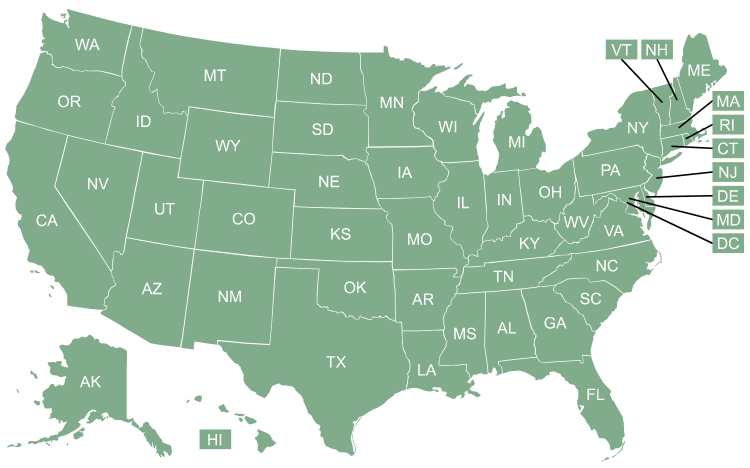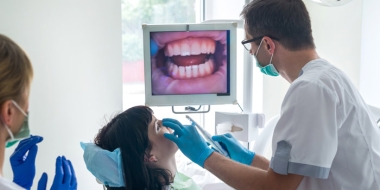Key takeaways
- What is dental insurance?
- What does dental insurance cover?
- See how dental insurance options vary depending on where you live.
- What costs can I expect with dental insurance?
- Do ACA health plans cover dental care?
- How can I buy adult dental coverage?
- How can I buy pediatric dental coverage?
- Tips for choosing dental insurance
- Types of dental insurance
- Read frequently asked questions about dental insurance.
Consumer demand for dental insurance in the U.S. is on the rise, and it’s increasing due to a growing prevalence of tooth decay as well as an increased awareness about the importance of oral hygiene. But – just like individual health insurance – your access to dental health insurance and dental coverage options can vary a lot depending on where you live.
We designed this dental insurance guide to explain:
- how dental insurance can benefit consumers
- where consumers can shop for dental coverage in the U.S.
- how much dental insurance might cost you and
- how you can find affordable coverage that fits your budget and needs.
What is dental insurance?
Dental insurance is insurance that covers a portion of basic dental expenses that you may encounter during a typical year, paying for procedures and treatments that generally improve and maintain your oral health.
Dental insurance is similar to health insurance in that:
- You pay a monthly premium for dental coverage
- Your dental plan will typically have a deductible
- Your dental plan may have preferred providers
Dental insurance has long been separate from medical insurance, although employers often offer a benefit package that includes both medical and dental insurance.
Dental insurance is often provided in conjunction with vision insurance, with both types of care covered under a single plan.
What does dental insurance cover?
The benefits and cost of your dental coverage will depend on whether your plan is offered by an employer, obtained through the health insurance marketplace, provided as part of your state’s Medicaid program, or purchased directly from a dental insurance company.
Your policy will likely give you access to free or very low-cost cleanings and routine exams. And it will probably cover a portion of the cost of fillings and extractions after your deductible is met.
Many plans will also pay some of the cost of more extensive dental work, such as root canals, crowns, endodontics, and periodontics. But the plan may have a waiting period for these services, or may cover a larger percentage of their cost after your plan has been in effect for a certain amount of time.
Some dental plans include benefits for cosmetic orthodontia services, although this is more common for employer-sponsored dental plans than self-purchased dental plans. Under pediatric dental coverage obtained via a health insurance marketplace, orthodontia will generally only be covered when considered medically necessary.
What are the costs of dental insurance?
Dental insurance premiums
For Americans who purchase their own stand-alone dental coverage, premiums are most commonly in the range of $20 to $50 per month. There are plans as low as $10/month, but to have any real coverage for major services, such as crowns and bridges, you should expect to pay at least $35/month.
If a family is purchasing coverage through the health insurance exchange, the premiums associated with pediatric dental coverage may or may not be offset by premium tax credits (premium subsidies). Here’s more about how that works, depending on whether the health plan has integrated pediatric dental benefits.
Non-premium dental costs
Dental insurance plans typically have deductibles that must be paid before treatment is provided. They also tend to have benefit caps that limit how much the insurance plan will pay for adult dental care. When a plan has a cap on how much it will pay, there is no limit to how high your out-of-pocket costs can be for adult dental care (this is the opposite of how most medical insurance plans work, as they will generally cap how much you pay, rather than how much the plan will pay).
Pediatric dental costs
For pediatric dental treatment, however, those are reversed if you buy a stand-alone dental plan through the exchange in your state: out-of-pocket costs are limited, and insurance benefits (the amount the insurance company will pay) are unlimited. This is more in line with the way health insurance works.
As of 2022, the out-of-pocket cap for pediatric dental services is $375 for one child, and $750 for a family (if there are multiple children on the family’s plan). But that only applies to stand-alone dental plans that are purchased in the exchange/marketplace. If a family buys a health plan that has embedded pediatric dental coverage, dental costs can be counted toward the plan’s overall deductible, meaning that out-of-pocket costs can be quite a bit higher.
Although pediatric dental is one of the ACA’s essential health benefits, premium subsidies may or may not be available to help cover the cost of the plan if it’s purchased as a separate stand-alone coverage.
Suggested reading on dental costs:
- If I buy a dental insurance plan what sort of out-of-pocket costs should I expect?
- Is it better for me to pay out of pocket for dental care and not worry about dental insurance?
How much does dental coverage vary by state?
In every part of the country, pediatric dental coverage has to be made available through the exchange — either as a stand-alone plan or integrated with the health plans that are available to families. Some states require all health plans to embed pediatric dental, while other states rely on stand-alone dental plans to provide this coverage.
For adults, dental coverage is rarely embedded in medical plans. But it’s widely available via stand-alone dental plans, either purchased through the exchange or directly from an insurance company. These plans will vary from state to state in terms of which insurers offer the coverage. But there tend to be a lot of similarities in terms of the coverage that’s offered on the available plans.
State Medicaid programs have to cover pediatric dental, but there is wide state-to-state variation in terms of how Medicaid covers adult dental care.
Does the Affordable Care Act provide dental coverage?
The Affordable Care Act included pediatric dental as one of the law’s essential health benefits – which means families can buy pediatric dental insurance through their state’s exchange – either embedded in a health insurance plan or through a separate, stand-alone policy.
Adult dental insurance coverage, however, is not required or regulated under the ACA.
How can I buy adult dental coverage?
Adult dental plans through ACA’s marketplace
For the most part, the Affordable Care Act didn’t help expand access to adult dental coverage. Dental insurance is generally available through the health insurance marketplace, but only during open enrollment or a special enrollment period, and often only in conjunction with an ACA-compliant health plan.
Here’s more about adult dental coverage through the marketplace:
- Dental insurance for adults
- Are dental benefits included in ACA’s marketplace health plans?
- Do ACA marketplace plans include coverage for adults?
Off-exchange adult dental coverage
In most cases, if you’re shopping outside of open enrollment, you’ll need to search for a dental plan name you recognize or a site that offers dental plan comparisons. These plans, sold directly by dental insurance companies or dental offices, are available year-round.
Medicaid/CHIP coverage of dental care
If you happen to have Medicaid coverage, be sure to check your state program to see what sort of adult dental coverage is provided. In most states, Medicaid covers at least some dental care for enrollees who are 21 and older. Some states offer emergency-only coverage, while about a third of states provide extensive dental coverage for adults through Medicaid.
Suggested reading:
Does Medicare cover dental care?
Coverage of routine dental care wasn’t built into Medicare coverage – and its coverage of dental expenses is limited to situations where the dental treatment is integral to other medical treatment. Examples might include an extraction prior to radiation treatment for oral cancer, or jaw reconstruction following an accident.
Many seniors who don’t have dental coverage from a former employer or through a spouse’s employer turn to Medicare Advantage. In 2022, 94% of Medicare Advantage plans provide at least some dental coverage. Others look to stand-alone dental plans – some of them specifically designed for seniors.
Suggested reading:
How can I get dental coverage for my child?
The ACA did improve dental coverage options for children. Under the ACA, pediatric dental insurance is considered an essential health benefit – and that means your state’s marketplace is required to offer dental coverage for your children – either embedded in a marketplace health insurance plan or available as a stand-alone plan.
Exchange-certified stand-alone pediatric dental plans available in your state will comply with the ACA’s pediatric dental coverage rules. This means out-of-pocket costs for pediatric dental care will not exceed $375 per child in 2022 (or $750 for all the children on a family’s plan), and there is no cap on medically-necessary pediatric dental benefits. (Note that if you purchase a family dental plan outside the exchange, it does not have to comply with the ACA’s rules for pediatric dental coverage, which means it will be able to limit how much the plan will pay for dental care, for both children and adults.)
As is the case for all essential health benefits, the specific coverage requirements for pediatric dental care are guided by your state’s essential health benefits benchmark plan. Click on your state using the map above to learn more.
Suggested reading:
- Is pediatric dental coverage included on exchange plans?
- Pediatric dental is one of the essential health benefits; does that mean my insurance will cover braces for my son?
- Embedded pediatric dental vs. stand-alone coverage: Pros and cons
Off-exchange pediatric dental
If you buy ACA-compliant health coverage outside of the marketplace, health insurance carriers are required to ensure that you have pediatric dental coverage. This can either be via pediatric dental benefits being embedded in the health plan, or you can attest that you have pediatric dental coverage from another source, such as a stand-alone plan.
Medicaid/CHIP pediatric dental
If your child is eligible for Medicaid or the Children’s Health Insurance Program, the coverage will include dental benefits that are generous and have low out-of-pocket costs. This is part of the Medicaid program’s Early and Periodic Screening, Diagnostic, and Treatment benefit, which is required to be provided in all states for Medicaid enrollees under the age of 21.
How to shop for dental insurance
If you have access to an employer-sponsored dental plan, that is likely going to provide the best value as your employer will probably subsidize a portion of the premiums. But assuming you need to purchase your own dental plan, there are several things to keep in mind:
- The health insurance marketplace/exchange in your state is a good place to start, particularly if you also need to purchase your own health insurance (you may find that you can only purchase dental coverage through the exchange if you’re also purchasing health insurance).
- If you have a particular dentist you want to keep seeing, you’ll want to check with them and see if they recommend any particular dental plans. They may be in-network with some plans and not others. If they do not participate in any dental plan networks, they may offer a discount for paying cash or a participation program that you can purchase and then use for discounts on any of the services they provide.
- When you’re comparing dental plans, pay close attention to things like waiting periods (generally only required for major services), deductibles, benefit caps, and monthly premiums. You may find that it’s worthwhile to pay a larger premium in order to have more extensive coverage (ie, a larger benefit cap) or a shorter waiting period for certain services.
- If you’re buying a health plan that has embedded dental coverage (fairly common for children, but not particularly common for adults), be sure you understand how the coverage works. For example, it may provide free cleanings and exams, but count all other dental services toward the overall medical deductible, which could be several thousand dollars.
Types of dental insurance
Dental plans can be managed care plans (ie, they have a network of participating dentists) or indemnity plans (ie, they pay a set amount for a particular service, regardless of what dentist you use).
Dental managed care plans tend to be HMOs or PPOs (for dental care, these are called DHMOs and DPPOs), but Dental Exclusive Provider Organizations (DEPO) and Dental Point of Service (DPOS) are available in some areas.
Here’s an overview of HMO, PPO, EPO, and POS as they’re used for medical insurance; the basic concepts are the same for dental plans. In general, DHMOs and DEPOs will only cover services provided by in-network dentists, and DHMOs will require your primary care dentist to provide a referral before you can see a specialist. DPPOs and DPOS plans will generally provide some out-of-network coverage, but your costs will be higher if you go outside the network.
Anytime you don’t use an in-network dentist (including any care you receive if you have a dental indemnity plan), your dentist can bill you for any amount of their charges that are above the “reasonable and customary” fee that the dental plan is willing to pay. This can be in addition to your plan’s regular deductible.






